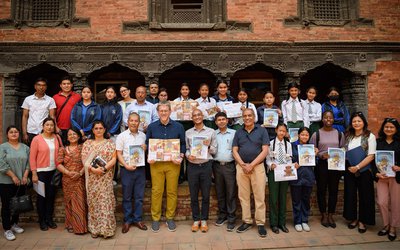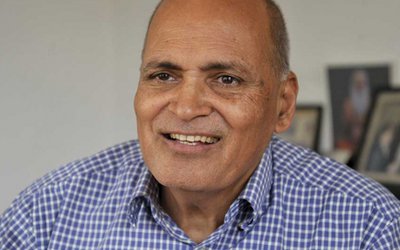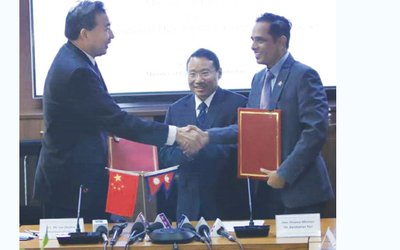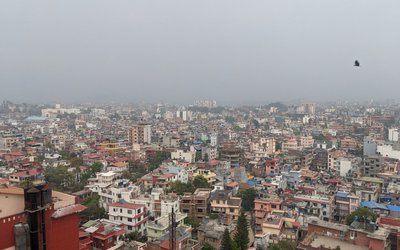
Strange indeed are the ways of Karma: my link with Toni Hagen started just before I was born till the time he passed away after writing his very last piece for a book Ropeways in Nepal that I was editing. My father, who subsequently became Nepal’s longest serving attorney general and then law minister, was then subba at Birganj Goswara with added duties of local judge and protocol officer receiving important foreign visitors to Nepal from Raxaul. Toni Hagen arrived in Nepal in 1950 towards the end of the Rana regime to begin his monumental geological journey across the Nepal Himalaya. He was received at the Birganj railway station by my father before being sent on to the last station at Amlekhganj and then (by foot) to Kathmandu. It was a clear day and he remembered Toni Hagen asking what the snow peaks seen from there were called. My father replied with the generic name as would any other Nepali who had not the faintest idea or interest in mountaineering: “Himal”, he said.
This was before I was born. My earliest memory of Toni Hagenwas around 1956 when as a young school student in St. Xaviers Jawlakhel, our principal Fr. Marshall Moran took a few of us for a walk to nearby Ekanta Kuna where the Swiss Mission’s office was located. I remember a bearded Toni Hagen and Fr. Moran with a few others seated around a table with a big cheese wheel in the center. With a kind of a hollow screw, they were extracting cheese bits from the inside, tasting them and plugging the hole back with the waxy rind head. Their conversation made no sense to us, but we were given a small piece to taste: we found it horribly stinky and awful in taste! Strange it is, and call it development or progress, that today I love cheese, especially the more stinky Roquefort variety, with beer!
That first cheese made in Nepal seems to have come fromJiri in Dolakha district where the originalThodung cheese factory had been set up by the Swiss. Jiri valley was on the trekking route from Kathmandu towards Mt. Everest, and the Swiss seem to have fallen in love with it as it reminded them so much of their own valleys in the Alps. It also symbolized the spirit of Swiss development cooperation in Nepal best described half-jokingly as follows: the Swiss first set up a cheese factory, then realized that a road was needed to transport the cheese to the market; they then proceeded to build the rather expensive (including to maintain) Lamosangu-Jiri road and only subsequently realized that development did not happen just because a road was built. Thus, was born their not very successful Integrated Hill Development Project (IHDP), the head office of which at Dandapakhar was abandoned after it was bombed by the Maoists.
Though without having much personal contact, I did come across the name of Toni Hagen in the late 1980s when I was working on an urban-rural interlinkage research project with the Swiss research firm INFRAS. The Swiss in Nepal were about to celebrate the 40th anniversary of Swiss-Nepal cooperation; and with Nepal reverting to multiparty democracy, there was a growing debate in Switzerland about what development cooperation was and should be. It had all started in 1951 with the idea of rural development meant to banish both rural impoverishment and rural-to-urban out migration. However, with almost four decades of development interventions, rural poverty, far from being banished, was increasing and outmigration to city areas was accelerating.
The debate in Switzerland – in which Toni Hagen was an important figure – was polarized between those who thought the way rural development was done should be revised for the better and those who thought it should be forgotten with the focus shifting to urban development. Our research was to understand what the underlying dynamics was in rural-urban interlinkages, and how one affected the other. To do this, we chose an innovative “toad’s eye science” method, identifying products that were urban (metal goods) and rural (perishable vegetables and fruits) and followed them up and down the supply and consumption chains to identify balance of trade, technology diffusion, resource colonization, as well as information and population exchange.
Our assumption was that metallic goods originated in urban areas whereas perishable vegetables came from rural farms. To our surprise, during the course of the research, we encountered a deep-rooted but dying tradition of village metal workers (kamis who made all the agri-implements but were being displaced by imports from India and China) and vegetables that came to rural areas either from urban wholesalers or were grown as per forward supply contracting by those in urban haat bazaars. To make matters worse, national as well as international donor policies were willy-nillyexternalizing economic, social, and environmental costs to favour urban areas and rural elites. Even the beneficial-sounding “forest conservation” was biased against rural kamis that made agri-implements (by prohibiting charcoal production they required) and favoured urban traders importing equipment from abroad.
This initial research led me to two further investigations. One was on Re-imagining the Rural-Urban Continuum supported by UK’s NERC, ESRC and DfID which explored the concept of desakota (from Bahasa Indonesia meaning neither rural nor urban or both in a mix of institutional strengths). It is an area which is both peri-urban and peri-rural – and dominates much of the Global South – where the hold of traditional rural institutions is in decline but where formal urban regulation is weak, tapering off or even non-existent. That seeming anarchy is an area of tremendous local innovations both social and technical, pointing to the need to not compartmentalize development into water-tight boxes such as rural or urban. These insights are even more important in today’s national Nepali context where the federal governance structure has devalued the concept of “rural” and replaced all rural governance mechanisms such as village development committees (VDCs) by “palikas” or municipalities, thus accelerating rural underdevelopment and rural to urban migration.
The second research was on a climate-friendly and mountain-friendly technology, the ropeway or cable car. It began with an attempt to increase the day-time load of micro-hydro plants by using their electricity to ferry goods from valley bottom (besi) to villages on hilltops (gaon). We selected Rangrung valley bottom in Gorkha district to Barpak village about five hours hike uphill as the pilot site to install a gaon-besi goods carrying ropeway. It was to be powered by unused day time electricity from local entrepreneur Bir Bahadur Ghale’s micro-hydro, with the financial support coming from British Ambassador Barney Smith.
When Toni Hagen learned of this, he managed to get hold of an auctioned off Swiss army’s goods-carrying ropeway, which was what was installed in Barpak. The action research proved that this technology, compared to even the most rudimentary dirt roads in the mountains of Nepal, is three times cheaper, eight times quicker to install, does not gouge mountain slopes leading to landslides, and uses only half the energy (that too clean hydropower) to transport goods than do dirty diesel-burning trucks. It is the best example of a mountain-friendly, climate-friendly and sustainability-friendly technology that, despite having come to Nepal exactly a century ago, is still to find proper place in Nepal’s transport policy. To acknowledge Toni Hagen’s critical contribution to rethinking rural access and rural development in Nepal, the book Ropeways in Nepalwas dedicated to his memory.
Today, as the Age of (Foreign) Aid is ending and neither the Age of New International Cooperation nor the rethinking development suitable to such a new order has found firm footing, Nepal faces the challenge of redefining its future. In the Age of Climate Change and the emerging new multipolar world, where new players and new values will define what apt versus mal development should mean, Nepalis will have to go back to their last century of development past to chart the way forward. In doing so, names of foreigners who made Nepal their karma bhoomi will stand out: Fr Moran for setting up the first modern English school, Drs Robert and Bethel Flemming for establishing the first modern hospitals, Odd Hoftun for developing Nepal’s hydropower as part of her innate technical capacity building – and Toni Hagen for laying the foundation for earth sciences of the Himalaya.
{This essay will appear in the book Dr Toni Hagen’s Approach on Sustainable Management of Agriculture, Biodiversity and Environment, to be published by Toni Hagen Foundation in February 2024}

Dipak Gyawali
Gyawali is Pragya (Academician) of the Nepal Academy of Science and Technology (NAST) and former minister of water resources.
- Maldevelopment And Technology: Ethos Harbingering Coming Apocalypse
- Apr 03, 2024
- World Social Forum: Rethinking and Redefining Development Itself
- Feb 21, 2024
- New World Disorder And The Case For Ideology
- Dec 13, 2023
- Loktantra’s Moral Turpitude
- Nov 06, 2023
- Will Nepal Leapfrog In Its Mobility?
- Sep 20, 2023















